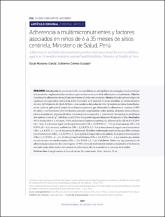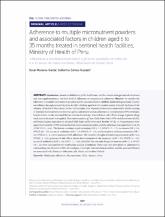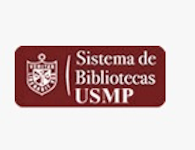Mostrar el registro sencillo del ítem
Adherencia a multimicronutrientes y factores asociados en niños de 6 a 35 meses de sitios centinela, Ministerio de Salud, Perú
| dc.contributor.author | Munares-García, Oscar | |
| dc.contributor.author | Gómez-Guizado, Guillermo | |
| dc.date.accessioned | 2020-06-09T20:48:01Z | |
| dc.date.available | 2020-06-09T20:48:01Z | |
| dc.date.issued | 2016 | |
| dc.identifier.citation | Munares O., Gómez G. Adherencia a multimicronutrientes y factores asociados en niños de 6 a 35 meses de sitios centinela, Ministerio de Salud, Perú. Rev. bras. epidemiol. 2016; 19(3): 539-553. | es_PE |
| dc.identifier.uri | https://hdl.handle.net/20.500.12727/6191 | |
| dc.description | ABSTRACT: Introduction: Anemia in children is a public health issue, and the current strategies include treatment and iron supplementation, but their level of adherence or compliance is unknown. Objective: To consider the adherence to multiple micronutrient powders and the associated factors. Methods: Epidemiological study of active surveillance through sentinel facilities in 2,024 children aged 6 to 35 months treated in health facilities of the Ministry of Health of Peru, from October to December 2014. Household visits were conducted in which counting of multiple micronutrient powders was applied and determined an adherence of consumption ≥ 90% envelopes, besides a form on the associated factors (anemia knowledge, iron-rich food, side effects, dosage regimen, drugs used, and motivation) was applied. Descriptive statistics, χ² test, Odds Ratio with a 95% confidence interval (CI), and binary logistic regression or adjusted Odds Ratio (aOR) were used. Results: Of all, 79.1% participants were aged 6 to 23 months; 75.9% received multiple micronutrient powders; and the adherence was equivalent to 24.4% (95%CI 22.3 - 26.6). The factors: continue supplementation (OR = 3.5; 95%CI 1.7 - 7.5); no nausea (OR = 3.0; 95%CI 2.0 - 4.3); no use of antibiotics (OR = 2.5; 95%CI 1.7 - 3.6); and intention to continue treatment (OR = 2.3; 95%CI 1.3 - 4.1) were associated with adherence. The variables: thought of continuing treatment (aOR = 2.6; 95%CI 1.1 - 6.1); presence of side effects, but no discontinuation of the treatment (aOR = 2.5; 95%CI 1.4 - 4.3); no use of antibiotics (aOR = 2.0; 95%CI 1.1 - 3.4); and belief that not only drugs cure anemia (aOR = 1.6; 95%CI 1.0 - 2.6) were associated in the multivariate analysis. Conclusion: There was a low prevalence of adherence to a demanding cut-off point (≥ 90% of envelopes of multiple micronutrient powders), and the associated factors are associated with absence of infections, side effects, and mother's beliefs. | es_PE |
| dc.description.abstract | Introducción: La anemia en el niño es un problema de salud pública, las estrategias actuales incluyen el tratamiento y suplementación con hierro, pero se desconoce su nivel de adherencia o cumplimiento. Objetivo: Considerar la adherencia a los multimicronutrientes y los factores asociados. Métodos: Estudio epidemiológico de vigilancia activa por sitios centinela en 2.024 niños entre los 6 hasta los 35 meses atendidos en establecimientos de salud del Ministerio de Salud del Perú, entre octubre a diciembre de 2014. Se realizaron visitas domiciliarias, en las cuales se aplicaron el conteo de multimicronutrientes, que determinó la adherencia al consumo ≥ 90% de sobres, y un formulario sobre los factores asociados (conocimiento sobre anemia, alimentos ricos en hierro, efectos secundarios, esquema de dosis, medicamentos consumidos y motivación). Se emplearon estadísticas descriptivas, el test del χ², Odds Ratio con IC95% y la regresión logística binaria u OR ajustado (ORa). Resultados: 79,1% tenían entre 6 a 23 meses, 75,9% recibieron multimicronutrientes y la adherencia fue del 24,4% (IC95% 22,3 - 26,6). Los factores: seguir con la suplementación (OR = 3,5; IC95% 1,7 - 7,5); no tener náuseas (OR = 3,0; IC95% 2,0 - 4,3); no tomar antibióticos (OR = 2,5; IC95% 1,7 - 3,6) e intenciones de seguir con el tratamiento (OR = 2,3; IC95% 1,3 - 4,1) se asociaron a la adherencia. El análisis multivariado asoció pensar que debe continuar con el tratamiento (ORa = 2,6; IC95% 1,1 - 6,1); si presentó algún efecto secundario, no suprimió el tratamiento (ORa = 2,5; IC95% 1,4 - 4,3), el niño no tomó antibióticos (ORa = 2,0; IC95% 1,1 - 3,4) y creencia que anemia no solo se cura con medicamentos (ORa = 1,6; IC95% 1,0 - 2,6). Conclusión: Hubo una baja prevalencia de adherencia para un punto de corte exigente (≥ 90% sobres de multimicronutrientes consumidos) y los factores asociados están relacionados con ausencia de infecciones, efectos secundarios y creencias de la madre. | es_PE |
| dc.description.sponsorship | Instituto Nacional de Salud, Lima, Perú | es_PE |
| dc.format.extent | pp. 539-553 | es_PE |
| dc.language.iso | spa | es_PE |
| dc.publisher | Associação Brasileira de Saúde Coletiva | es_PE |
| dc.relation.ispartof | urn:issn:0036-3634 | |
| dc.relation.ispartofseries | Revista Brasileira de Epidemiologia;vol. 19, no. 3 | |
| dc.relation.uri | https://doi.org/10.1590/1980-5497201600030006 | es_PE |
| dc.rights | info:eu-repo/semantics/openAccess | es_PE |
| dc.rights.uri | https://creativecommons.org/licenses/by/4.0/ | es_PE |
| dc.source | Repositorio Académico USMP | es_PE |
| dc.source | Universidad San Martín de Porres - USMP | es_PE |
| dc.subject | Cumplimiento de la medicación | es_PE |
| dc.subject | Micronutrientes | es_PE |
| dc.subject | Niño | es_PE |
| dc.subject | Anemia | es_PE |
| dc.subject | Perú | es_PE |
| dc.title | Adherencia a multimicronutrientes y factores asociados en niños de 6 a 35 meses de sitios centinela, Ministerio de Salud, Perú | es_PE |
| dc.title.alternative | Adherence to multiple micronutrient powders and associated factors in children aged 6 to 35 months treated in sentinel health facilities, Ministry of Health of Peru | es_PE |
| dc.type | info:eu-repo/semantics/article | es_PE |
| thesis.degree.name | Medicina Humana | es_PE |
| thesis.degree.grantor | Universidad de San Martín de Porres. Facultad de Medicina Humana | es_PE |
| thesis.degree.discipline | Medicina | es_PE |
| dc.publisher.country | BR | es_PE |
| dc.subject.ocde | https://purl.org/pe-repo/ocde/ford#3.02.00 | es_PE |
Ficheros en el ítem
Este ítem aparece en la(s) siguiente(s) colección(es)
-
Artículos [274]









